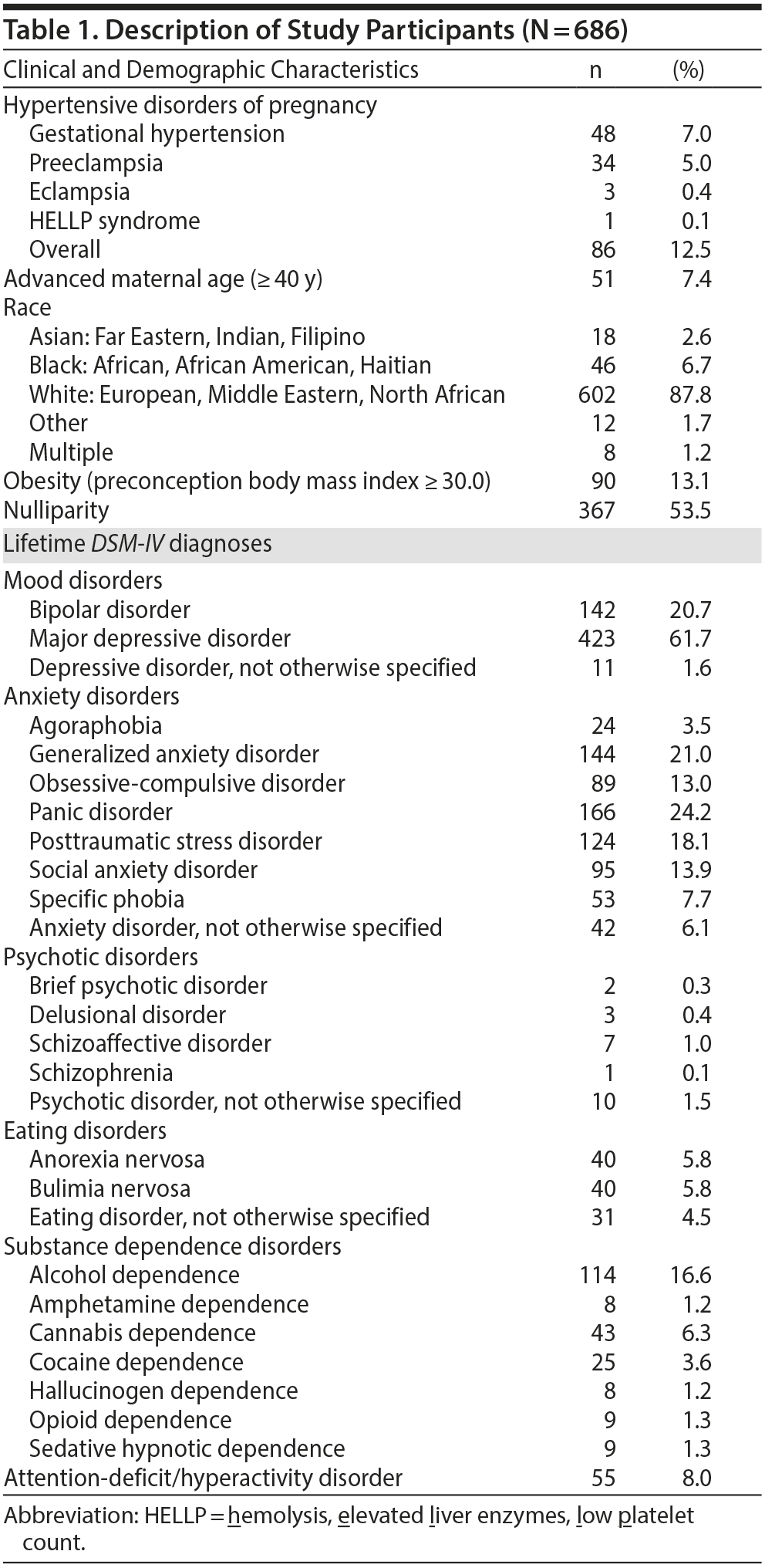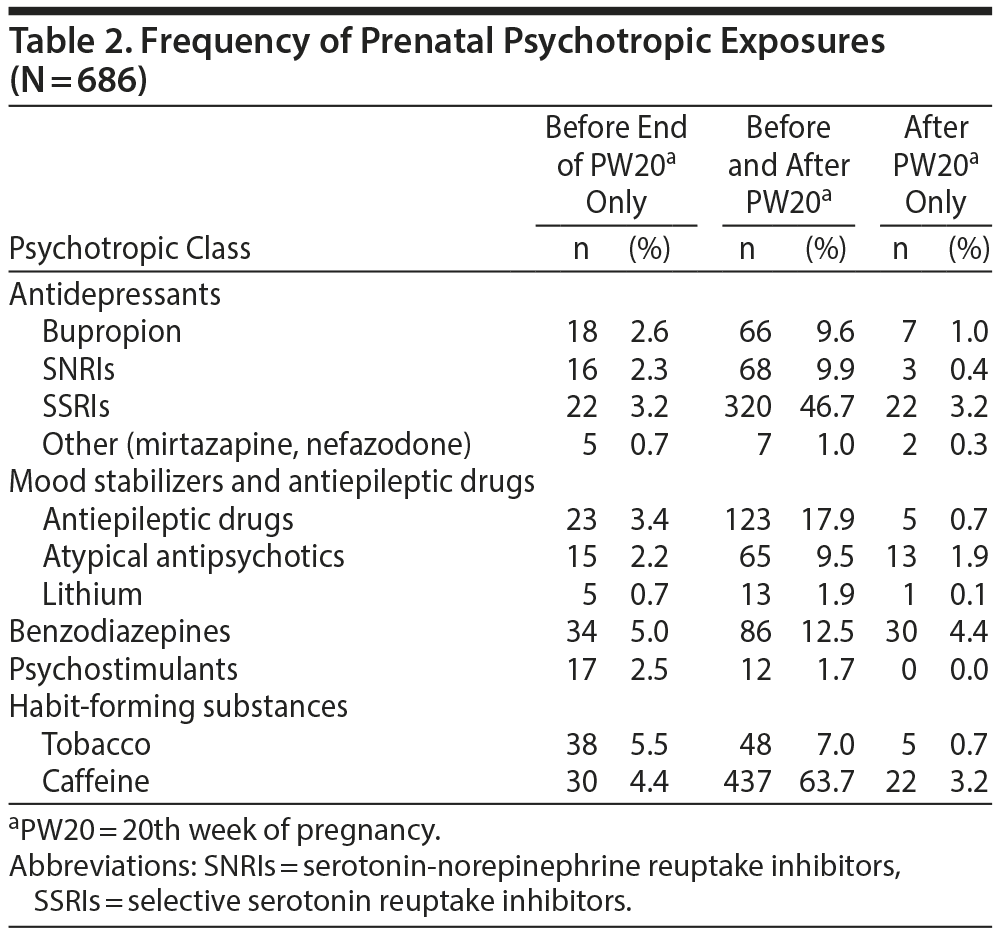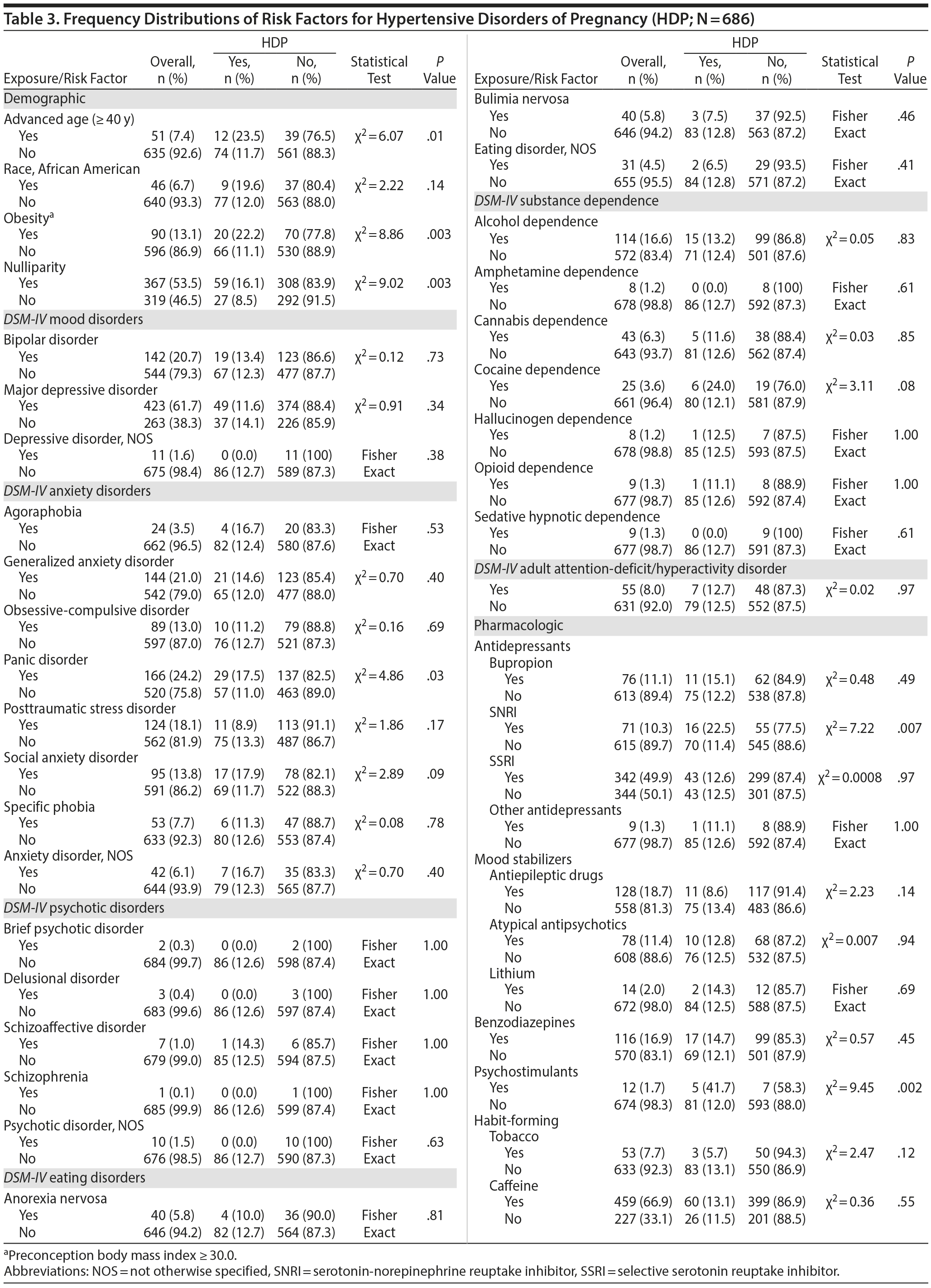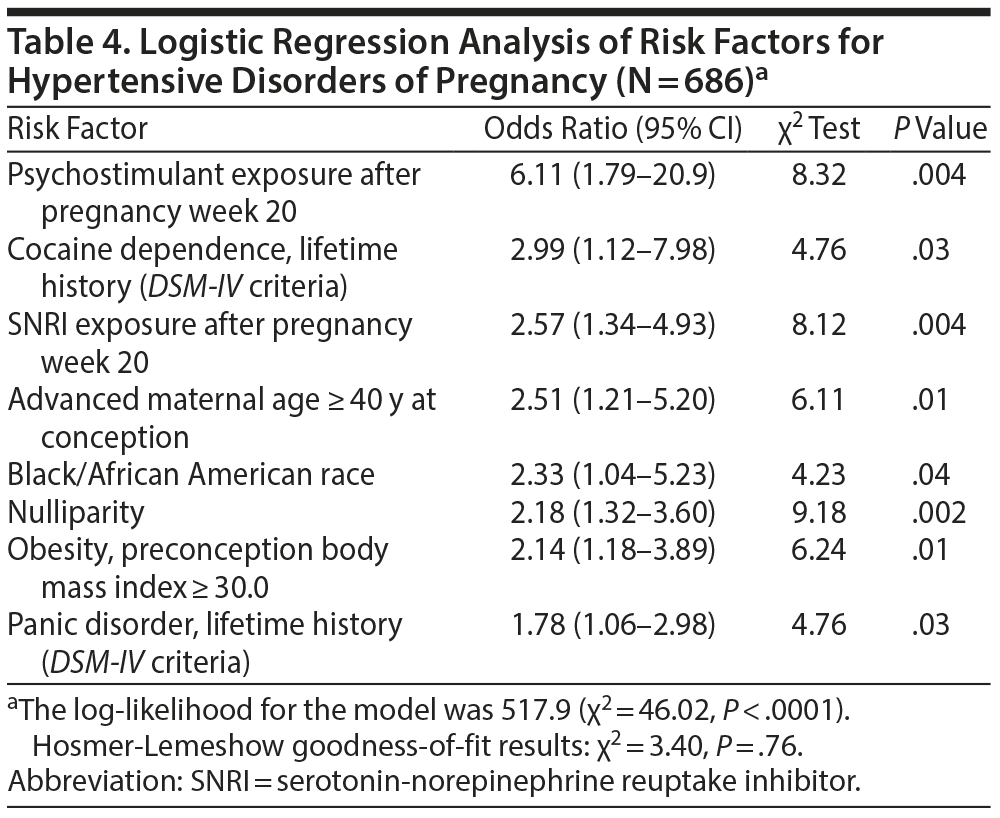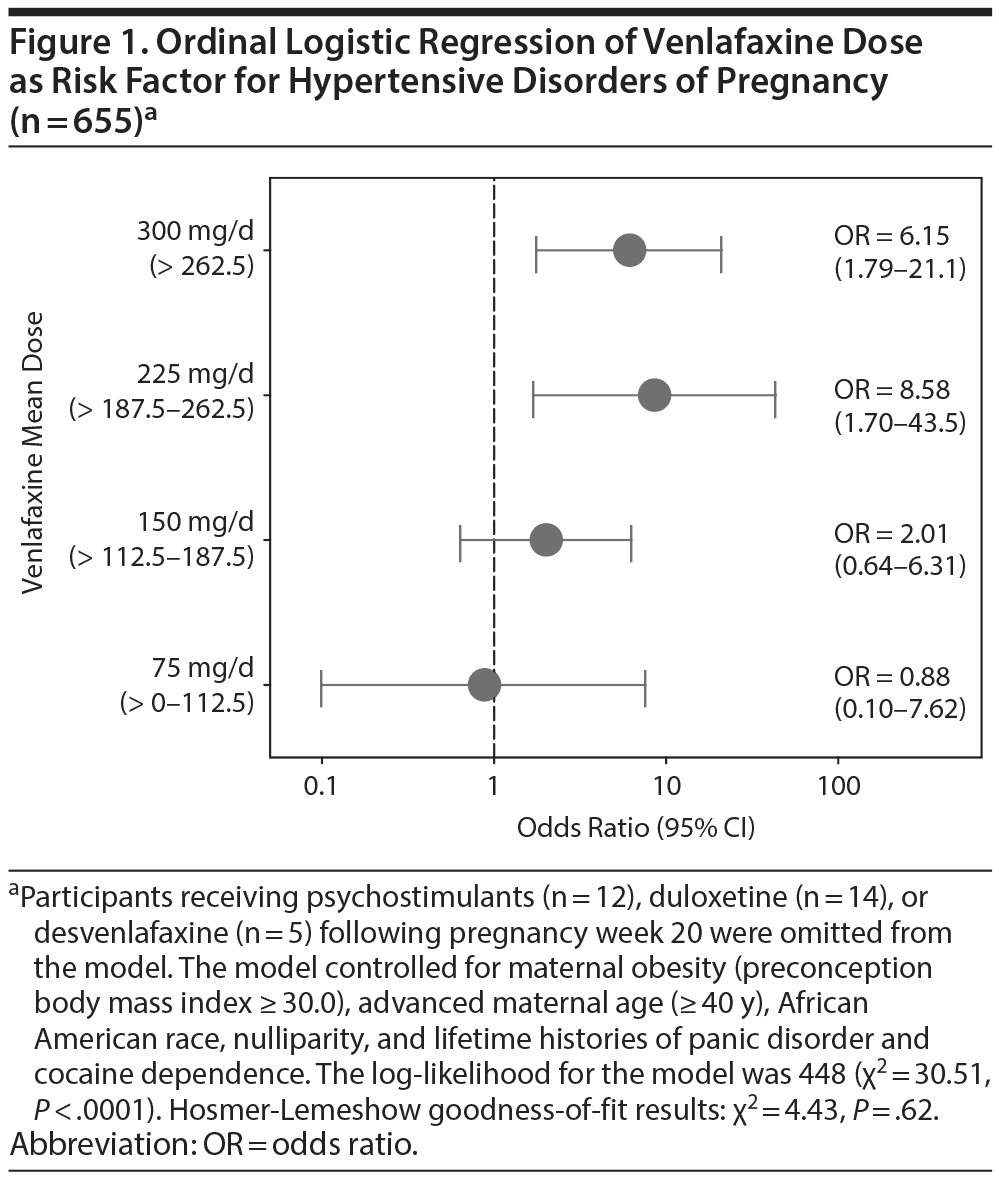Objective: To investigate the association, if any, of prenatal mental illness and psychotropic exposure with the risk of hypertensive disorders of pregnancy (HDP).
Methods: A case-cohort analysis was conducted of 686 pregnant women participating in prospective, longitudinal observational studies in a tertiary referral center between January 1998 and May 2012. Risk estimates were produced using multivariate logistic regression modeling. Medication- and diagnosis-specific data were utilized to conduct post hoc confirmatory analyses of the risk estimates.
Results: After adjustment for confounders, HDP were significantly associated with psychostimulant (odds ratio [OR] = 6.11; 95% CI, 1.79-20.9) and serotonin-norepinephrine reuptake inhibitor (SNRI) (OR = 2.57; 95%, 1.34-4.93) exposure following the 20th week of gestation and lifetime histories of cocaine dependence (OR = 2.99; 95% CI, 1.12-7.98) and panic disorder (OR = 1.78; 95% CI, 1.06-2.98) using DSM-IV diagnostic criteria. HDP risk was not associated with prenatal selective serotonin reuptake inhibitor exposure or other psychiatric disorders. Post hoc analyses demonstrated an increased risk for HDP with higher maternal daily doses of amphetamine psychostimulants and the SNRI venlafaxine.
Conclusions: These data indicate that psychostimulant and SNRI exposure following the 20th week of gestation conveys considerable risk for the emergence of HDP. Overall, the findings suggest that heightened vascular reactivity to noradrenergic, rather than serotonergic, stimulation may be pivotal to HDP risk among women with psychiatric illness.
Abstract
Objective: To investigate the association, if any, of prenatal mental illness and psychotropic exposure with the risk of hypertensive disorders of pregnancy (HDP).
Methods: A case-cohort analysis was conducted of 686 pregnant women participating in prospective, longitudinal observational studies in a tertiary referral center between January 1998 and May 2012. Risk estimates were produced using multivariate logistic regression modeling. Medication- and diagnosis-specific data were utilized to conduct post hoc confirmatory analyses of the risk estimates.
Results: After adjustment for confounders, HDP were significantly associated with psychostimulant (odds ratio [OR] = 6.11; 95% CI, 1.79-20.9) and serotonin-norepinephrine reuptake inhibitor (SNRI) (OR = 2.57; 95%, 1.34-4.93) exposure following the 20th week of gestation and lifetime histories of cocaine dependence (OR = 2.99; 95% CI, 1.12-7.98) and panic disorder (OR = 1.78; 95% CI, 1.06-2.98) using DSM-IV diagnostic criteria. HDP risk was not associated with prenatal selective serotonin reuptake inhibitor exposure or other psychiatric disorders. Post hoc analyses demonstrated an increased risk for HDP with higher maternal daily doses of amphetamine psychostimulants and the SNRI venlafaxine.
Conclusions: These data indicate that psychostimulant and SNRI exposure following the 20th week of gestation conveys considerable risk for the emergence of HDP. Overall, the findings suggest that heightened vascular reactivity to noradrenergic, rather than serotonergic, stimulation may be pivotal to HDP risk among women with psychiatric illness.
J Clin Psychiatry 2016;77(11):1538–1545
dx.doi.org/10.4088/JCP.15m10506
© Copyright 2016 Physicians Postgraduate Press, Inc.
aDepartments of Psychiatry and Behavioral Sciences and Obstetrics and Gynecology, University of Miami Miller School of Medicine, Miami, Florida
bPrivate Practice, Atlanta, Georgia
cNell Hodgson Woodruff School of Nursing, Emory University, Atlanta, Georgia
dDepartments of Psychiatry and Behavioral Sciences and ePediatrics and Obstetrics and Gynecology, University of Arkansas for Medical Sciences, Little Rock
*Corresponding author: D. Jeffrey Newport, MD, Women’s Reproductive Mental Health, University of Miami Miller School of Medicine, 1120 NW 14th St, Ste 1446, Miami, FL 33136 ([email protected]).
Addressing the safety concerns of prenatal psychotropic exposure, a Practice Bulletin issued by the American Congress of Obstetricians and Gynecologists (ACOG) advises that mental health care decisions during pregnancy “incorporate an appraisal of the clinical consequences of offspring [medication] exposure, the potential effect of untreated maternal psychiatric illness, and the available alternative therapies.”1(p1001) Consequently, a thorough evaluation of the risks attributable to both mental illness and its treatment is requisite to evidence-based prenatal decision-making.
Accurate risk-benefit assessment is hindered by reliance upon an incomplete reproductive safety literature that is complicated by methodological differences often yielding inconsistent results.2 In numerous instances, the same adverse outcome has been attributed to both a maternal mental disorder and a psychiatric medication. Such is the case for hypertensive disorders of pregnancy (HDP), including gestational hypertension, preeclampsia, eclampsia, and HELLP (hemolysis, elevated liver enzymes, low platelet count) syndrome.
Numerous psychotropic medications have been associated with nonpuerperal hypertension; however, the risk of HDP among women using psychotropic medications has had limited scrutiny. Two recent studies3,4 suggested a relationship between gestational hypertension and selective serotonin reuptake inhibitor (SSRI) use. Other studies reported an association between preeclampsia and antidepressant use in general5 and serotonin-norepinephrine reuptake inhibitor (SNRI) or tricyclic antidepressant (TCA) use in particular.6,7 Conversely, some studies,8,9 although not all,6,10 have reported higher rates of HDP in association with maternal depression and anxiety. A recent meta-analysis11 reported a significant association between antenatal depression and preeclampsia; however, none of the 5 studies included in the meta-analysis controlled for concomitant antidepressant use. In most existing studies, prospective documentation of medication exposure and structured assessments of maternal psychiatric diagnosis and symptoms are lacking.
Recognizing the increasing rate of prenatal psychotropic administration,12–15 the prevalence of mental disorders among women of reproductive age, and evidence indicating that prenatal recurrence is common in the absence of continued pharmacotherapy,16,17 studies elucidating the comparative risks of untreated prenatal mental illness versus prenatal psychotropic exposure are critically important. This study aimed to describe the relationship between HDP and both prenatal maternal mental illness and commonly prescribed psychotropics.
METHODS
Study participants were enrolled before conception or during early gestation (ie, no later than 16 weeks estimated gestational age) in a prospective observational study of the course and outcomes associated with maternal mental illness and treatment. They were recruited from referrals by primary care physicians, obstetricians, or mental health care providers to the Emory Women’s Mental Health Program in Atlanta, Georgia. All participants provided written informed consent to participate, following approval by the Emory Institutional Review Board. Data were collected between January 1998 and May 2012.
Utilizing a case-cohort design, the analysis sought to identify mental disorders and classes of psychoactive substances associated with HDP. Outcome ascertainment was determined via structured abstraction of the obstetrical record by an experienced obstetrical nurse (B.T.K.). Women with chronic hypertension, defined as hypertension predating conception or arising before the 20th week of pregnancy (PW20), were excluded from analysis. Those diagnosed by their obstetrical care providers using ACOG–recommended diagnostic criteria for HDP, including gestational hypertension, preeclampsia, eclampsia, or HELLP syndrome, were designated cases; those with no history of hypertension were designated controls. ACOG-recommended diagnostic criteria for gestational hypertension18 require 2 blood pressure measurements equal to or exceeding 140/90 mm Hg or a single blood pressure measurement equal to or exceeding 160/110 mm Hg after 20 weeks of gestation. The ACOG criteria for preeclampsia18 require gestational hypertension plus proteinuria or new onset of any of the following after PW20: thrombocytopenia, impaired hepatic function, renal insufficiency, pulmonary edema, cerebral symptoms, or visual symptoms.
Inclusion was limited to participants who, by the time of data sequestration, had delivered a live singleton infant and for whom the following data had been collected: (1) determination of HDP via abstraction of obstetrical record, (2) prospective documentation of medication exposure recording the daily dose of all agents on a week-by-week basis across gestation, (3) psychiatric diagnostic assessment utilizing the Structured Clinical Interview for DSM-IV-TR Axis I Disorders, Research Version, Patient Edition (SCID-I/P)19 and a clinician interview supplemented by the Conners’ Adult ADHD Rating Scales (CAARS),20 and (4) serial assessments of depressive and anxiety symptoms during pregnancy using the Hamilton Rating Scales for Depression (HDRS)21 and Anxiety (HARS)22 and the Beck Depression Inventory (BDI).23
A preliminary series of bivariate comparisons was conducted, examining HDP risk factors including known demographic and clinical risk factors (ie, maternal age greater than or equal to 40 years, African American ethnicity, nulliparity, and obesity),24 Diagnostic and Statistical Manual for Mental Disorders, Fourth Edition, Text Revision (DSM-IV-TR)25 lifetime Axis I diagnoses, exposure to various classes of psychoactive substances following PW20, and the occurrence of a major depressive episode (MDE) or significant depressive or anxiety symptoms following PW20, using contingency table methods (χ2 with 1 degree of freedom) or Student t test. By definition, onset of HDP occurs after PW20; therefore, post-PW20 was designated the window of interest for assessing exposure risk.
Factors with suggestive associations (P ≤ .10) with HDP were evaluated by stepwise (α = .10 for model entry and α = .05 for model retention) multivariate logistic regression modeling. Finally, available medication-specific and diagnosis-specific data were utilized to examine dose effects of exposure in post hoc confirmatory analyses of mental disorders or agent classes demonstrating an association with HDP in the logistic regression.
RESULTS
Participant Characteristics
A total of 713 women qualified for the analysis. A group of 27 women with chronic hypertension were excluded leaving 686 women available for subsequent analyses. Eighty-six (12.5%) of the remaining participants were diagnosed with HDP (Table 1).
The sample was homogeneous, primarily composed of white (n = 602, 87.8%), married (n = 576, 84.0%), college graduates (n = 459, 66.9%) with a mean age of 33.1 ± 5.0 years and receiving prenatal care (n = 686, 100%). Most pregnancies were planned (n = 470, 68.5%) and desired (n = 549, 80.0%). Frequencies of documented HDP risk factors in the sample included nulliparity (n = 367, 53.5%), maternal obesity (preconception body mass index ≥ 30.0; n = 90, 13.1%), African or African American race (n = 46, 6.7%), and maternal age of 40 years and older (n = 51, 7.4%).
Most participants (n = 635, 92.6%) fulfilled DSM-IV criteria for a lifetime Axis I disorder. Frequencies within DSM-IV diagnostic categories included 84.0% (n = 576) with mood disorder, 61.8% (n = 424) with anxiety disorder, 21.7% (n = 149) with substance dependence disorder, 16.2% (n = 111) with an eating disorder, 8.0% (n = 55) with attention deficit disorder, and 3.4% (n = 23) with psychotic disorder histories. Lifetime rates of individual DSM-IV Axis I disorders are reported in Table 1. A major depressive episode was experienced by 21.5% (n = 144; missing data, n = 15) of the participants during pregnancy, with 14.5% (n = 98) experiencing a prenatal MDE before PW20 only, 12.4% (n = 83) after PW20, and 9.1% (n = 61) fulfilling criteria in both halves of gestation.
Most study participants were treated with at least 1 psychotropic agent during pregnancy (n = 607, 88.5%), with antidepressant exposure the most frequent (n = 489, 71.3%), followed by mood stabilizers (n = 214, 31.2%), benzodiazepines (n = 150, n = 21.9%), and psychostimulants (n = 29, 4.2%). Whereas over half (n = 17, 58.6%) of those receiving psychostimulant therapy in early pregnancy discontinued the medication before PW20 (Table 2), other classes of psychotropic agents were continued after PW20 by at least two-thirds of those treated during early gestation.
Bivariate Analyses of HDP Risk Factors
The planned bivariate analyses demonstrated associations for HDP with most recognized risk factors (Table 3) including maternal obesity (22.2% vs 11.1%, P = .003), nulliparity (16.1% vs 8.5%, P = .003), and advanced maternal age (23.5% vs 11.7%, P = .01). The higher frequency of HDP among African American participants did not achieve statistical significance (19.6% vs 12.0%, P = .14).
Bivariate analyses of HDP frequencies in association with DSM-IV Axis I disorders (Table 3) demonstrated an association with lifetime histories of panic disorder (17.5% vs 11.0%, χ2 = 4.86, P = .03) and nonsignificant trends with cocaine dependence (24.0% vs 12.1%, χ2 = 3.11, P = .08) and social anxiety disorder (17.9% vs 11.7%, χ2 = 2.89, P = .09). The occurrence of HDP was not associated with the severity of post-PW20 depressive or anxiety symptoms (operationalized as area under the curve for HDRS, BDI, and HARS scores) or the occurrence of a post-PW20 MDE (data not shown). Nor was there any association with pre-PW20 depressive or anxiety symptoms (data not shown).
Bivariate analyses of psychotropic exposures (including tobacco and caffeine) following PW20 (Table 3) demonstrated significant associations for HDP with SNRIs (22.5% vs 11.4%, χ2 = 7.22, P = .007) and psychostimulants (41.7% vs 12.0%, χ2 = 9.45, P = .002). Contrary to previous reports,3,4 there was no evidence of an association between HDP and SSRI exposure (12.6% vs 12.5%, χ2 = 0.0008, P = .97).
Logistic Regression of HDP Risk Factors
Candidate predictors to the logistic regression analysis included nulliparity; obesity; advanced maternal age; African American race; lifetime histories of panic disorder, cocaine dependence, and social anxiety disorder; and post-PW20 exposure to SNRIs and psychostimulants. Due to the historical association with HDP, African American race was included as a candidate predictor despite the bivariate analysis failing to fulfill the a priori criterion for model inclusion. All candidate predictors except social anxiety disorder were retained in the final reduced model (Table 4). Of note, the magnitude of association between HDP and established risk factors was exceeded by the association with a lifetime history of cocaine dependence (odds ratio [OR] = 2.99) and post-PW20 SNRI exposure (OR = 2.57) and more than doubled by the association with post-PW20 psychostimulant exposure (OR = 6.11).
Post Hoc Analysis of HDP Association
With SNRI Exposure
The 71 participants receiving SNRI therapy after PW20 included 5 desvenlafaxine exposures, none diagnosed with HDP; 14 duloxetine exposures with 3 (21.4%) HDP diagnoses; and 52 venlafaxine exposures with 13 (25.0%) HDP diagnoses.
An ordinal logistic regression, controlling for all covariates retained in the final logistic regression model, was conducted to assess dose effects of venlafaxine exposure. Participants exposed to psychostimulants, desvenlafaxine, or duloxetine were excluded a priori to isolate the association between venlafaxine and HDP. Results of the model (Figure 1) demonstrated a significant positive association between HDP and post-PW20 venlafaxine doses exceeding 187.5 mg/d. The odds ratio for HDP at these doses rivaled that of psychostimulant exposure and more than doubled that for other documented risk factors.
Post Hoc Analysis of HDP Association
With Psychostimulant Exposure
The 12 participants receiving post-PW20 psychostimulant therapy included 2 with methylphenidate exposure, neither of whom were diagnosed with HDP; 1 with lisdexamfetamine exposure who also was not diagnosed with HDP; and 9 with amphetamine (either dextroamphetamine or mixed amphetamine salts) exposure, 5 (55.6%) of whom were diagnosed with HDP. Among the 9 women with post-PW20 amphetamine exposure, those diagnosed with HDP had significantly higher mean daily amphetamine doses (33.8 mg/d [95% CI, 17.6 to 50.1] vs 11.9 mg/d [95% CI, −2.2 to 25.9], t = 2.86, P = .02) and higher peak daily amphetamine doses (36.0 mg/d [95% CI, 17.2 to 54.8] vs 16.3 mg/d [95% CI, 4.3 to 28.2], t = 2.36, P = .05) after PW20 than those without HDP diagnoses.
Post Hoc Analysis of HDP Association
With Panic Disorder
Administration of the Panic Disorder Severity Scale (PDSS)26 was added to the protocol in January 2006; therefore, PDSS scores were available for only 94 (56.6%) of the 166 participants with lifetime histories of panic disorder. Student t tests revealed no difference in post-PW20 peak or mean PDSS scores among those with versus without HDP (data not shown). Nor was there any association with pre-PW20 PDSS scores (data not shown).
Post Hoc Analysis of HDP Association
With Cocaine Dependence
Perinatal urine drug screens were completed for most (n = 558, 81.3%) of the study participants, including 22 (88.0%) of the 25 subjects with lifetime histories of cocaine dependence. None of the urine samples collected during pregnancy tested positive for cocaine; however, 3 participants provided cocaine-positive urine samples at 4 to 5 months postpartum. Notably, all 3 participants provided urine samples during pregnancy that tested negative for cocaine, and none of the 3 participants with a postpartum cocaine-positive urine drug screen were diagnosed with HDP.
DISCUSSION
These data indicate that SNRI and psychostimulant exposure following PW20 convey considerable risk for the emergence of HDP. This should not be surprising, as hypertension has been reported with venlafaxine27 and psychostimulant28 therapy in nongravid adults.
In contrast to 2 recent studies,3,4 SSRI exposure was not associated with HDP in the current study. Although De Vera and Bérard4 reported a higher rate (OR = 1.60; 95% CI, 1.00–2.55) of gestational hypertension among SSRI-treated gravidas, closer inspection of their report reveals that paroxetine was the only SSRI significantly associated with HDP (OR = 1.81; 95% CI, 1.02–3.23). Paroxetine has been shown to possess in vivo norepinephrine reuptake inhibition activity29 and could arguably, therefore, be classified as an SNRI rather than an SSRI.
Toh and colleagues,3 in a retrospective analysis utilizing data from the Slone Epidemiology Center Birth Defects Study, reported an even greater association between SSRI exposure and HDP (OR = 2.49; 95% CI, 1.62–3.83). This study3 did not have a sufficient number of exposures to examine SNRI-associated outcomes. Furthermore, this study relied upon phone interviews conducted up to 6 months following delivery to ascertain exposure status,3 a method that has previously been shown to be subject to systematic recall bias.30
Although the pathophysiology of HDP has not been definitively elucidated, numerous studies31–34 of preeclampsia suggest a role for cardiovascular maladaptation marked by endothelial dysfunction and heightened vascular reactivity to sympathetic stimulation. Yet, there remains debate as to the respective roles of serotonergic versus noradrenergic activity in the pathogenesis of HDP. Some researchers, for example, have posited that direct vasoconstrictive properties of serotonin play a central role in the etiology of HDP, or at least in the reported occurrence of iatrogenic HDP during SSRI therapy.35
Findings from the current study and others,6,7 however, suggest that sensitization to noradrenergic rather than serotonergic activity may be pivotal to HDP risk among women with psychiatric illness. Psychostimulants, cocaine, and SNRIs, the latter at high doses, are each known to increase norepinephrine signaling. The dose-response relationship of psychostimulants and SNRIs with HDP in the current study lends additional credence to the role of sympathetic hyperreactivity, particularly in light of the relative increase in norepinephrine transporter blockade by venlafaxine as the daily dose exceeds 150 mg.36
Yet, the association of HDP with a lifetime history of cocaine dependence, despite the absence of cocaine use during gestation, seems counterintuitive. Might this be explained by a heightened vascular reactivity to sympathetic/noradrenergic stimulation precipitated during the prior period of extensive cocaine use that persists during subsequent periods of abstinence? Chronic cocaine exposure has, in fact, been shown to produce an up-regulation of norepinephrine transporters within the central nervous system of nonhuman primates.37 Similarly, enduring changes in cortical function have been reported in abstinent adults with past histories of extensive cocaine use.38,39 Perhaps most intriguing are studies in numerous animal models demonstrating persistent vascular hyperreactivity following prenatal cocaine exposure.40–42 Nevertheless, it is unclear whether similarly enduring vascular effects are seen in humans following chronic cocaine exposure during adolescence or early adulthood.
Panic disorder, a syndrome with considerable evidence linking it to sympathetic dysregulation,43 was also associated with HDP in the current study. However, the relationship was not dependent on the presence or severity of active panic symptomatology during the latter half of gestation. Consistent with this finding is an investigation of baroreflex function in panic disorder demonstrating that heightened vasoreactivity is a trait rather than state characteristic of the syndrome.44
Ultimately, the putative roles of noradrenergic and serotonergic dysfunction in conveying risk for HDP among pregnant women with psychiatric illness or receiving psychiatric medication are not necessarily mutually exclusive. Serotonergic potentiation of noradrenergic activity may instead underlie the pathogenesis of HDP. Indeed, serotonin-mediated amplification of noradrenergic vasoconstriction of the human umbilical artery has been reported.45
There are numerous clinical implications raised by the findings of the current study. Heightened prenatal screening for HDP may be indicated for women with histories of panic disorder or cocaine dependence. Indeed, obstetrical outcome among women with panic disorder is an important yet neglected area for clinical investigation. Given the frequent comorbidity of panic disorder and depression, it may be that adverse obstetrical outcomes reported in studies of depression may instead be attributable to unmonitored comorbidities such as panic disorder.
In addition, alternatives to SNRIs and psychostimulants should be considered, particularly for women with prior histories of HDP. If the risk-benefit evaluation determines that these agents should be administered during pregnancy, then vigilant dose monitoring is warranted.
Although the current study’s generalizability is arguably limited by utilization of a homogeneous sample recruited from a tertiary care center, the results (with respect to HDP rate and association with demographic risk factors) parallel those from community samples, suggesting that the findings may be relevant to other populations. It may be argued that the absence of a healthy volunteer control group limits the study; however, disentangling effects of medication versus illness exposure requires careful psychiatric control (ie, continued vs discontinued treatment; relapsed vs remitted illness) that a nonpsychiatric control group fails to afford. Other potential limitations include the incomplete data on certain preconception risk factors for HDP such as family history of hypertension46,47 and lack of screening for postdelivery onset of preeclampsia. However, these limitations are offset by numerous unique strengths of the current analysis. The exposure data collected in the study were extensive (encompassing a broad array of both maternal mental illnesses and pharmacologic exposures from numerous psychotropic classes), detailed (including both the level and the timing of exposure), and collected prospectively at serial longitudinal visits (thereby avoiding recall bias). The comprehensive nature of the data afforded an opportunity to extend the data analysis beyond hypothesis testing to incorporate post hoc confirmatory tests.
In summary, pregnant women with histories of mental illness often face challenging clinical decisions weighing the respective risks of untreated maternal illness versus maternal use of psychiatric medication during pregnancy. The current report adds to the available evidence necessary to inform clinical decision-making during gestation.
Submitted: October 31, 2015; accepted February 29, 2016.
Drug names: bupropion (Wellbutrin and others), desvenlafaxine (Pristiq, Khedezla, and others), dextroamphetamine (Dexedrine and others), duloxetine (Cymbalta), lisdexamfetamine (Vyvanse), lithium (Lithobid and others), methylphenidate (Ritalin and others), mixed amphetamine salts (Adderall XR and others), mirtazapine (Remeron and others), paroxetine (Paxil, Pexeva, and others).
Potential conflicts of interest: Dr Newport has received research support from NARSAD (Brain & Behavior Research Foundation), the National Institutes of Health, Eli Lilly, GlaxoSmithKline, Janssen, and Wyeth, and speaker’s honoraria from AstraZeneca, Eli Lilly, GlaxoSmithKline, and Pfizer. Ms Knight has received research support from Bristol-Myers Squibb, Cyberonics, Eli Lilly, Forest, Janssen, Novartis, and Wyeth; and her adult, nondependent son is employed by and holds stock options for GlaxoSmithKline. Dr Stowe has received research support from and consulted to GlaxoSmithKline, Pfizer, and Wyeth, and received speakers’ honoraria from the same companies as well as from Eli Lilly and Forest. Drs Hostetter and Juul and Ms Porterfield have nothing to disclose. No coauthor holds equity positions in pharmaceutical or biomedical corporations.
Funding/support: This work was supported by US National Institutes of Health grants MH-77928, MH-71531, and MH-68036 and a NARSAD Independent Investigator Award (D.J.N.).
Role of the sponsor: The supporters had no role in the design, analysis, interpretation, or publication of this study.
Previous presentation: Presented, in part, in oral format at the 59th Annual Meeting of the Academy of Psychosomatic Medicine; November 16, 2012; Atlanta, Georgia, and in poster format at the Annual Meeting of the Georgia Psychiatric Physicians Association; February 16, 2013; Atlanta, Georgia.
REFERENCES
1. ACOG Committee on Practice Bulletins—Obstetrics. ACOG Practice Bulletin: clinical management guidelines for obstetrician-gynecologists number 92, April 2008 (replaces practice bulletin number 87, November 2007). use of psychiatric medications during pregnancy and lactation. Obstet Gynecol. 2008;111(4):1001–1020. PubMed doi:10.1097/AOG.0b013e31816fd910
2. Newport DJ, Stowe ZN. Psychopharmacology during pregnancy and lactation. In: Schatzberg AF, Nemeroff CB, eds. Essentials of Clinical Psychopharmacology. 3rd ed. Washington, DC: American Psychiatric Publishing, Inc.; 2013:751–787.
3. Toh S, Mitchell AA, Louik C, et al. Selective serotonin reuptake inhibitor use and risk of gestational hypertension. Am J Psychiatry. 2009;166(3):320–328. PubMed doi:10.1176/appi.ajp.2008.08060817
4. De Vera MA, Bérard A. Antidepressant use during pregnancy and the risk of pregnancy-induced hypertension. Br J Clin Pharmacol. 2012;74(2):362–369. PubMed doi:10.1111/j.1365-2125.2012.04196.x
5. Reis M, Källén B. Delivery outcome after maternal use of antidepressant drugs in pregnancy: an update using Swedish data. Psychol Med. 2010;40(10):1723–1733. PubMed doi:10.1017/S0033291709992194
6. Palmsten K, Setoguchi S, Margulis AV, et al. Elevated risk of preeclampsia in pregnant women with depression: depression or antidepressants? Am J Epidemiol. 2012;175(10):988–997. PubMed doi:10.1093/aje/kwr394
7. Palmsten K, Huybrechts KF, Michels KB, et al. Antidepressant use and risk for preeclampsia. Epidemiology. 2013;24(5):682–691. PubMed doi:10.1097/EDE.0b013e31829e0aaa
8. Kurki T, Hiilesmaa V, Raitasalo R, et al. Depression and anxiety in early pregnancy and risk for preeclampsia. Obstet Gynecol. 2000;95(4):487–490. PubMed
9. Qiu C, Sanchez SE, Lam N, et al. Associations of depression and depressive symptoms with preeclampsia: results from a Peruvian case-control study. BMC Womens Health. 2007;7:15. PubMed doi:10.1186/1472-6874-7-15
10. Katon WJ, Russo JE, Melville JL, et al. Depression in pregnancy is associated with preexisting but not pregnancy-induced hypertension. Gen Hosp Psychiatry. 2012;34(1):9–16. PubMed doi:10.1016/j.genhosppsych.2011.09.018
11. Hu R, Li Y, Zhang Z, et al. Antenatal depressive symptoms and the risk of preeclampsia or operative deliveries: a meta-analysis. PLoS One. 2015;10(3):e0119018. doi:10.1371/journal.pone.0119018 PubMed
12. Bakker MK, Kölling P, van den Berg PB, et al. Increase in use of selective serotonin reuptake inhibitors in pregnancy during the last decade, a population-based cohort study from the Netherlands. Br J Clin Pharmacol. 2008;65(4):600–606. PubMed doi:10.1111/j.1365-2125.2007.03048.x
13. Bobo WV, Davis RL, Toh S, et al. Trends in the use of antiepileptic drugs among pregnant women in the US, 2001–2007: a medication exposure in pregnancy risk evaluation program study. Paediatr Perinat Epidemiol. 2012;26(6):578–588. PubMed doi:10.1111/ppe.12004
14. Barbui C, Conti V, Purgato M, et al. Use of antipsychotic drugs and mood stabilizers in women of childbearing age with schizophrenia and bipolar disorder: epidemiological survey. Epidemiol Psychiatr Sci. 2013;22(4):355–361. PubMed doi:10.1017/S2045796013000012
15. Toh S, Li Q, Cheetham TC, et al. Prevalence and trends in the use of antipsychotic medications during pregnancy in the US, 2001–2007: a population-based study of 585,615 deliveries. Arch Women Ment Health. 2013;16(2):149–157. PubMed doi:10.1007/s00737-013-0330-6
16. Cohen LS, Altshuler LL, Harlow BL, et al. Relapse of major depression during pregnancy in women who maintain or discontinue antidepressant treatment. JAMA. 2006;295(5):499–507. PubMed doi:10.1001/jama.295.5.499
17. Viguera AC, Whitfield T, Baldessarini RJ, et al. Risk of recurrence in women with bipolar disorder during pregnancy: prospective study of mood stabilizer discontinuation. Am J Psychiatry. 2007;164(12):1817–1824. PubMed doi:10.1176/appi.ajp.2007.06101639
18. Roberts JM, August PA, Bakris G, et al; American College of Obstetricians and Gynecologists; Task Force on Hypertension in Pregnancy. Hypertension in pregnancy: report of the American College of Obstetricians and Gynecologists’ Task Force on Hypertension in Pregnancy. Obstet Gynecol. 2013;122(5):1122–1131. PubMed
19. First MB, Spitzer RL, Gibbon M, et al. Structured Clinical Interview for DSM-IV-TR Axis I Disorders, Research Version, Patient Edition (SCID-I/P). New York, NY: Biometrics Research, New York State Psychiatric Institute; 2002.
20. Conners CK, Erhardt D, Sparrow E. Conners’ Adult ADHD Rating Scales (CAARS). Technical Manual. North Tonawanda, NY: Multi-Health Systems; 1999.
21. Hamilton M. A rating scale for depression. J Neurol Neurosurg Psychiatry. 1960;23:56–62. PubMed doi:10.1136/jnnp.23.1.56
22. Hamilton M. The assessment of anxiety states by rating. Br J Med Psychol. 1959;32(1):50–55. PubMed doi:10.1111/j.2044-8341.1959.tb00467.x
23. Beck AT, Rial WY, Rickels K. Short form of depression inventory: cross-validation. Psychol Rep. 1974;34(3):1184–1186. PubMed
24. Sibai BM. Hypertension. In: Gabbe SG, Niebyl JR, Simpson JL, et al, eds. Obstetrics: Normal and Problem Pregnancies. 6th ed. Philadelphia, PA: Elsevier Saunders; 2012:779–824. doi:10.1016/B978-1-4377-1935-2.00035-1
25. American Psychiatric Association. Diagnostic and Statistical Manual for Mental Disorders. Fourth Edition, Text Revision. Washington, DC: American Psychiatric Association; 2000.
26. Shear MK, Brown TA, Barlow DH, et al. Multicenter collaborative Panic Disorder Severity Scale. Am J Psychiatry. 1997;154(11):1571–1575. PubMed doi:10.1176/ajp.154.11.1571
27. Thase ME. Effects of venlafaxine on blood pressure: a meta-analysis of original data from 3,744 depressed patients. J Clin Psychiatry. 1998;59(10):502–508. PubMed doi:10.4088/JCP.v59n1002
28. Mick E, McManus DD, Goldberg RJ. Meta-analysis of increased heart rate and blood pressure associated with CNS stimulant treatment of ADHD in adults. Eur Neuropsychopharmacol. 2013;23(6):534–541. PubMed doi:10.1016/j.euroneuro.2012.06.011
29. Gilmor ML, Owens MJ, Nemeroff CB. Inhibition of norepinephrine uptake in patients with major depression treated with paroxetine. Am J Psychiatry. 2002;159(10):1702–1710. PubMed doi:10.1176/appi.ajp.159.10.1702
30. Newport DJ, Brennan PA, Green P, et al. Maternal depression and medication exposure during pregnancy: comparison of maternal retrospective recall to prospective documentation. BJOG. 2008;115(6):681–688. PubMed doi:10.1111/j.1471-0528.2008.01701.x
31. Schobel HP, Fischer T, Heuszer K, et al. Preeclampsia—a state of sympathetic overactivity. N Engl J Med. 1996;335(20):1480–1485. PubMed doi:10.1056/NEJM199611143352002
32. Lewinsky RM, Riskin-Mashiah S. Autonomic imbalance in preeclampsia: evidence for increased sympathetic tone in response to the supine-pressor test. Obstet Gynecol. 1998;91(6):935–939. PubMed
33. Yang CC, Chao TC, Kuo TB, et al. Preeclamptic pregnancy is associated with increased sympathetic and decreased parasympathetic control of HR. Am J Physiol Heart Circ Physiol. 2000;278(4):H1269–H1273. PubMed
34. Mishra N, Nugent WH, Mahavadi S, et al. Mechanisms of enhanced vascular reactivity in preeclampsia. Hypertension. 2011;58(5):867–873. PubMed doi:10.1161/HYPERTENSIONAHA.111.176602
35. Bolte AC, van Geijn HP, Dekker GA. Pathophysiology of preeclampsia and the role of serotonin. Eur J Obstet Gynecol Reprod Biol. 2001;95(1):12–21. PubMed doi:10.1016/S0301-2115(00)00367-5
36. Debonnel G, Saint-André E, Hébert C, et al. Differential physiological effects of a low dose and high doses of venlafaxine in major depression. Int J Neuropsychopharmacol. 2007;10(1):51–61. PubMed doi:10.1017/S1461145705006413
37. Beveridge TJR, Smith HR, Nader MA, et al. Effects of chronic cocaine self-administration on norepinephrine transporters in the nonhuman primate brain. Psychopharmacology (Berl). 2005;180(4):781–788. PubMed doi:10.1007/s00213-005-2162-1
38. Volkow ND, Hitzemann R, Wang GJ, et al. Long-term frontal brain metabolic changes in cocaine abusers. Synapse. 1992;11(3):184–190. PubMed doi:10.1002/syn.890110303
39. Bolla KI, Eldreth DA, London ED, et al. Orbitofrontal cortex dysfunction in abstinent cocaine abusers performing a decision-making task. Neuroimage. 2003;19(3):1085–1094. PubMed doi:10.1016/S1053-8119(03)00113-7
40. Arbeille P, Maulik D, Salihagic A, et al. Effect of long-term cocaine administration to pregnant ewes on fetal hemodynamics, oxygenation, and growth. Obstet Gynecol. 1997;90(5):795–802. PubMed doi:10.1016/S0029-7844(97)00361-X
41. Pourcyrous M, Bada HS, Blaho KE, et al. Chronic prenatal exposure to cocaine alters cerebrovascular responses in newborn pigs. Exp Biol Med (Maywood). 2004;229(8):819–825. PubMed
42. Xiao D, Huang X, Xu Z, et al. Prenatal cocaine exposure differentially causes vascular dysfunction in adult offspring. Hypertension. 2009;53(6):937–943. PubMed doi:10.1161/HYPERTENSIONAHA.108.121830
43. Esler M, Eikelis N, Schlaich M, et al. Human sympathetic nerve biology: parallel influences of stress and epigenetics in essential hypertension and panic disorder. Ann N Y Acad Sci. 2008;1148:338–348. PubMed doi:10.1196/annals.1410.064
44. Lambert EA, Thompson J, Schlaich M, et al. Sympathetic and cardiac baroreflex function in panic disorder. J Hypertens. 2002;20(12):2445–2451. PubMed doi:10.1097/00004872-200212000-00025
45. Rothlin RP, Sardi SP, Spaccavento D, et al. Amplification of contractile response by serotonin on noradrenaline in the human umbilical artery [in Spanish]. Medicina (B Aires). 1995;55(6):652–658. PubMed
46. Roes EM, Sieben R, Raijmakers MT, et al. Severe preeclampsia is associated with a positive family history of hypertension and hypercholesterolemia. Hypertens Pregnancy. 2005;24(3):259–271. PubMed doi:10.1080/10641950500281076
47. Bezerra PC, Leão MD, Queiroz JW, et al. Family history of hypertension as an important risk factor for the development of severe preeclampsia. Acta Obstet Gynecol Scand. 2010;89(5):612–617. PubMed doi:10.3109/00016341003623720
Enjoy free PDF downloads as part of your membership!
Save
Cite
Advertisement
GAM ID: sidebar-top
